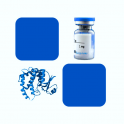
- Remove this product from my favorite's list.
- Add this product to my list of favorites.
Products
Newsletter
 |  |  |  |  |  |

Background
The Fas also known as FAS receptor (FasR), apoptosis antigen 1 (APO-1 or APT), cluster of differentiation 95 (CD95) or tumor necrosis factor receptor superfamily member 6 (TNFRSF6). is a death receptor on the surface of cells that leads to programmed cell death (apoptosis). It is one of two apoptosis pathways, the other being the mitochondrial pathway. FasR is located on chromosome 10 in humans and 19 in mice. Similar sequences related by evolution (orthologs) are found in most mammals. Fas forms the death-inducing signaling complex (DISC) upon ligand binding. Membrane-anchored Fas ligand trimer on the surface of an adjacent cell causes trimerization of Fas receptor. This event is also mimicked by binding of an agonistic Fas antibody, though some evidence suggests that the apoptotic signal induced by the antibody is unreliable in the study of Fas signaling. To this end, several clever ways of trimerizing the antibody for in vitro research have been employed.Upon ensuing death domain (DD) aggregation, the receptor complex is internalized via the cellular endosomal machinery. This allows the adaptor molecule FADD to bind the death domain of Fas through its own death domain. Recently, Fas has also been shown to promote tumor growth, since during tumor progression, it is frequently downregulated or cells are rendered apoptosis resistant. Cancer cells in general, regardless of their Fas apoptosis sensitivity, depend on constitutive activity of Fas. This is stimulated by cancer-produced Fas ligand for optimal growth.
Source
Recombinant Human Fas /CD95 Protein, Fc Tag (MALS verified) (FAS-H5252) is expressed from human 293 cells (HEK293). It contains AA Gln 26 - Asn 173 (Accession # AAH12479.1).
Predicted N-terminus: Gln 26
Molecular Characterization
This protein carries a human IgG1 Fc tag at the C-terminus. The protein has a calculated MW of 42.8 kDa. The protein migrates as 50-66 kDa under reducing (R) condition (SDS-PAGE) due to glycosylation.
Endotoxin
Less than 1.0 EU per μg by the LAL method.
Purity
>95% as determined by SDS-PAGE.
>90% as determined by SEC-MALS.
Formulation
Lyophilized from 0.22 μm filtered solution in 50 mM Tris, 100 mM Glycine, pH7.5 with trehalose as protectant.
Reconstitution
See Certificate of Analysis for details of reconstitution instruction and specific concentration.
Storage
For long term storage, the product should be stored at lyophilized state at -20°C or lower.
Please avoid repeated freeze-thaw cycles.
This product is stable after storage at:
-20°C to -70°C for 12 months in lyophilized state;
-70°C for 3 months under sterile conditions after reconstitution.
Bioactivity
Please refer to product data sheet.
(1) "Impact of chronic psychological stress on platelet membrane fatty acid composition in a rat model of type 1 diabetes Mellitus"
Bikulčienė, Baleišis, Mazgelytė et al
Lipids Health Dis (2024) 23 (1), 69
(2) "Futile lipid cycling: from biochemistry to physiology"
Sharma, Khandelwal, Wolfrum
Nat Metab (2024)
(3) "Stimulation of estrogen receptor-alpha by hydroxyanilide fungicide, fenhexamid promotes lipid accumulation in 3 T3-L1 adipocyte"
Jung, Jeong, Lee
Pestic Biochem Physiol (2024) 199, 105757
Showing 1-3 of 44320 papers.
Follow us